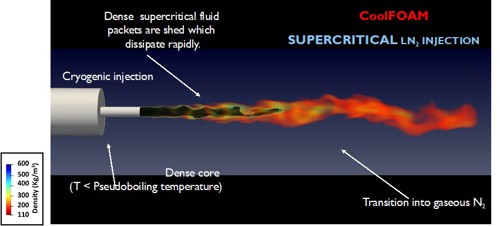Cryogenics Fluid Dynamics Lab, Department of Engineering Science, University of Oxford: Fundamentals of Multiphase Cryogenic Processes
Fundamentals of Multiphase Cryogenic Processes
Fundamentals of Multiphase Cryogenic Processes
One of the dominant characteristics of cryogenic fluids is that they are gases at atmospheric conditions, but they find application mostly in liquid state that they acquire at low temperatures and/or high pressures. When in liquid state, in many of the above-mentioned applications they appear in the form of liquid jets injected in domains with prevailing pressures and/or temperatures commonly above their critical point.
Understanding the factors that control the thermophysical behaviour of cryogenic liquids and jet dynamics during injection is very important for the better control of the processes and the design of cryogenic systems. Although we have a good understanding as to how jet dynamics associated with phase change, heat transfer and mixing occur when “hot fluids” are present -mostly though the research relevant to combustion systems- what happens with the dynamics of “cold fluids” is less clear. We know that ultra-cold temperatures can have profound effects on fluids at the molecular level but still we do not know how the changes in the molecular level affect processes and jet dynamics occurring at the macroscale.
Within the group we focus on:
- Modelling thermophysical properties of cryogenic fluids at a range of operating conditions using real fluid thermodynamics
- Developing sub grid scale models for phase change and turbulence specifically tailored to perform accurately in simulations involving ultra low temperatures.
- Investigating supercritical flow regimes which have a particular manifestation at cryogenic fluids due to their low critical points.
We have developed a new code within OpenFOAM suit called CoolFOAM which is available upon request from Konstantina.vogiatzaki@eng.ox.ac.uk
The code currently offers the following capabilities a) Weak compressibility (pressure-based) b) Real Fluid Thermodynamics through Polynomial fitting and Tabulation c) Supercritical Phase Change and c) Diffusive mixing.


